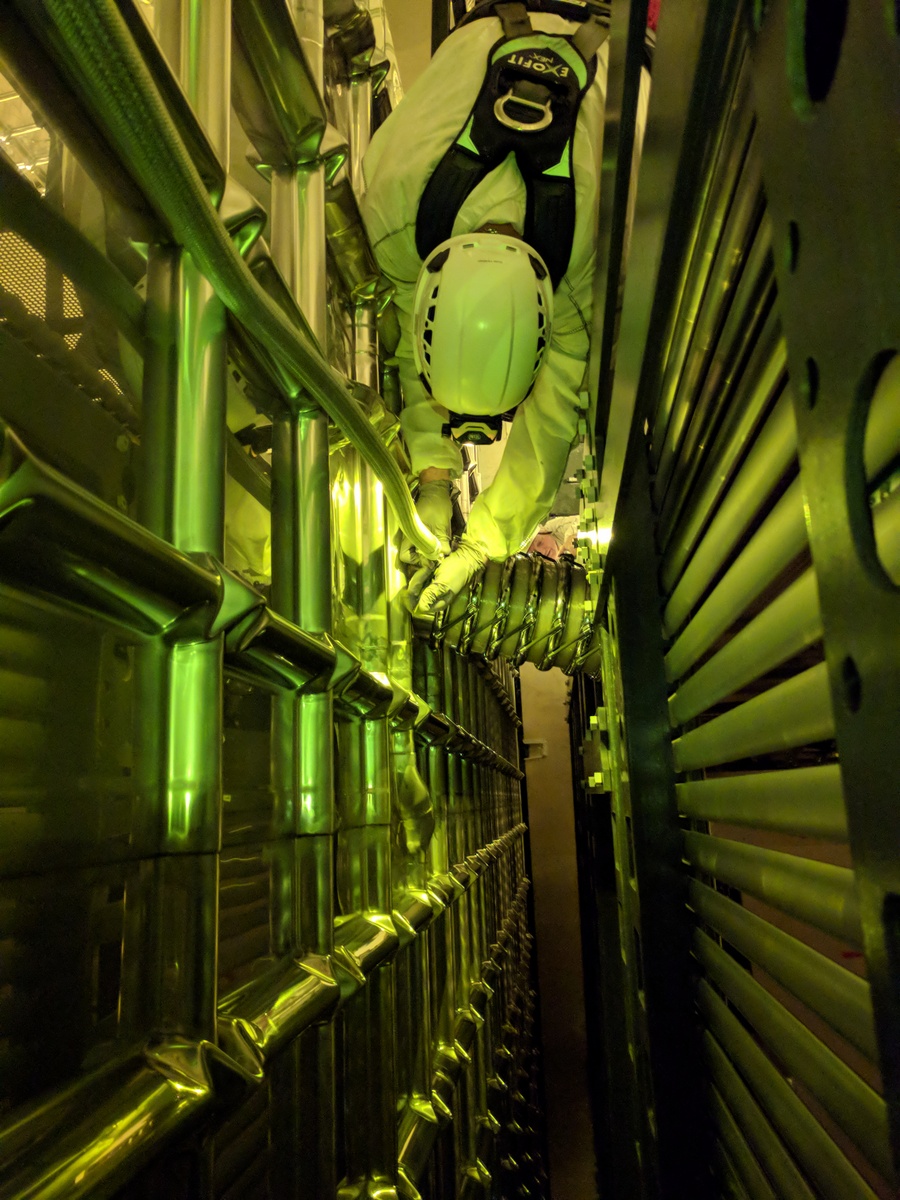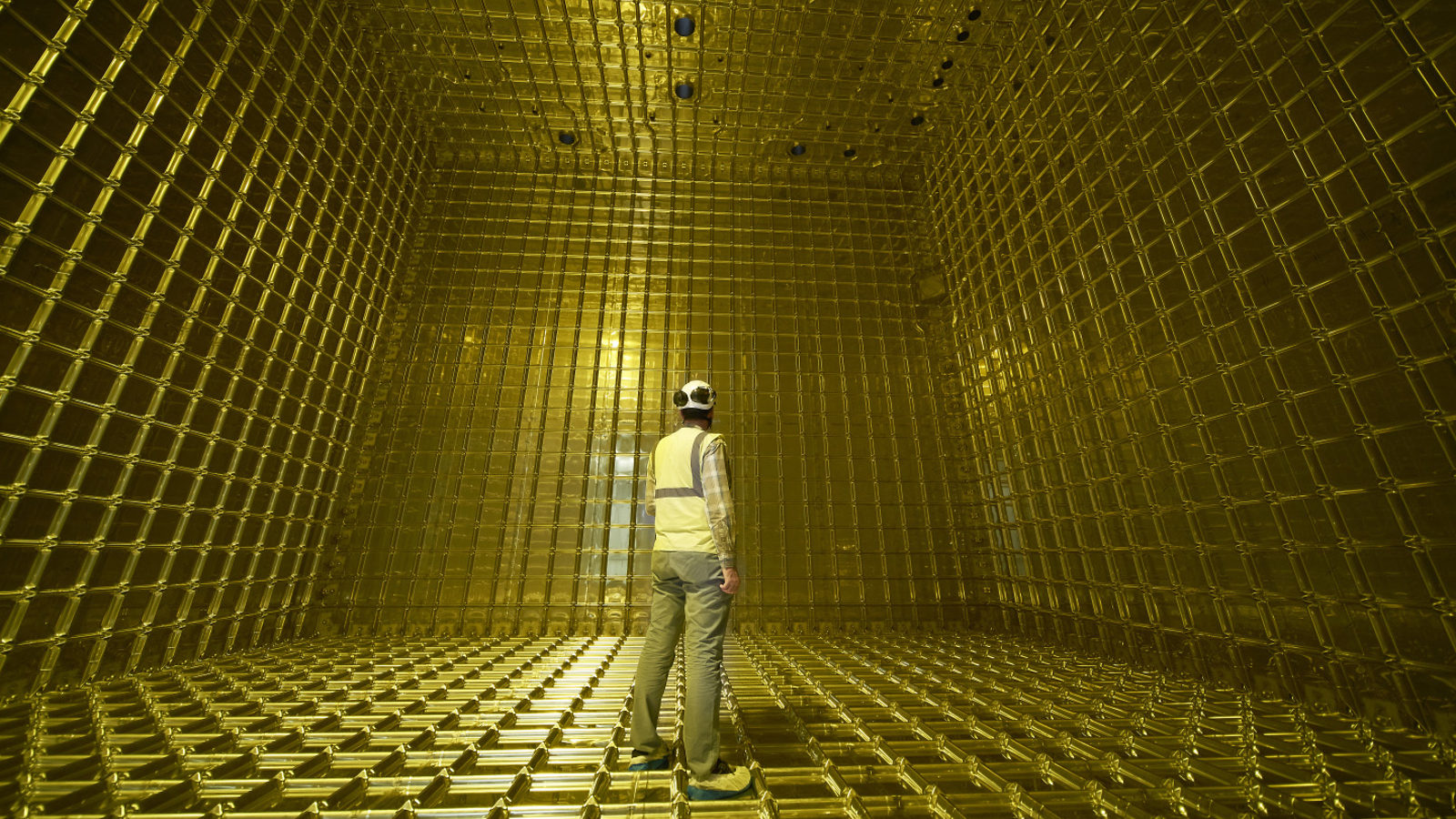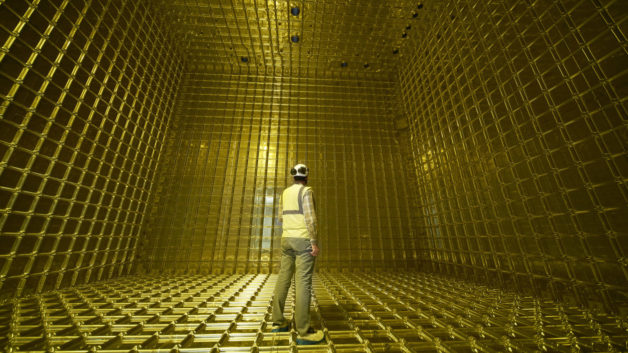Note: This article was adapted from an original press release published by Fermi National Accelerator Laboratory. View the original release.
The largest liquid-argon neutrino detector in the world has just recorded its first particle tracks, signaling the start of a new chapter in the story of the international Deep Underground Neutrino Experiment (DUNE).
DUNE’s scientific mission is dedicated to unlocking the mysteries of neutrinos, the most abundant (and most mysterious) matter particles in the universe. Neutrinos are all around us, but we know very little about them. Scientists on the DUNE collaboration think that neutrinos may help answer one of the most pressing questions in physics: why we live in a universe dominated by matter. In other words, why we are here at all.
The enormous ProtoDUNE detector – the size of a three-story house and the shape of a gigantic cube – was built at CERN, the European Laboratory for Particle Physics, as the first of two prototypes for what will be a much, much larger detector for the DUNE project, hosted by the U.S. Department of Energy’s Fermi National Accelerator Laboratory in the United States. When the first DUNE detector modules record data in 2026, they will each be 20 times larger than these prototypes.
It is the first time CERN is investing in infrastructure and detector development for a particle physics project in the United States.
The first ProtoDUNE detector took two years to build and eight weeks to fill with 800 tons of liquid argon, which needs to be kept at temperatures below minus 184 degrees Celsius (minus 300 degrees Fahrenheit). The detector records traces of particles in that argon, from both cosmic rays and a beam created at CERN’s accelerator complex. Now that the first tracks have been seen, scientists will operate the detector over the next several months to test the technology in depth.

A team from Berkeley Lab worked on the beam window – the cylindrical, ringed object in the middle of the photo – for ProtoDUNE. A particle beam at CERN enters the cryostat wall from the left of the photo, through the middle of the beam window, and then gets injected into the detector volume shown at the right of the photo. The region shown in the photo has since been filled with liquid argon chilled to minus 300 degrees Fahrenheit. (Credit: Berkeley Lab)
DOE’s Lawrence Berkeley National Laboratory (Berkeley Lab) led the design, fabrication, and installation of the beam window system for ProtoDUNE. The beam window allows charged particles from the CERN beam line to be injected inside the liquid argon cryostat.
“This is one of the most challenging pieces of equipment that I have built,” said Cheng-Ju Stephen Lin, a Berkeley Lab staff scientist in the Physics Division who has been working on ProtoDUNE since 2014. “It has to withstand high voltage (165 kilovolts), works in a cryogenic environment, and is composed of lightweight materials to minimize particle scattering and energy loss.”
Timothy Loew, William Waldron, and Joe Wallig from Berkeley Lab’s Engineering Division also contributed to the beam window effort: Loew designed the beam window structures, Waldron worked on high-voltage compatibility, and Wallig designed a nitrogen gas filter and control system.
Some of the major components for the beam window project were fabricated at Berkeley Lab. The beam window was delivered to Fermilab in the summer of 2017 and underwent several months of testing before it was shipped to CERN in early 2018. Also, Peter Madigan, a graduate researcher at Berkeley Lab, participated in the first tracks observations while he was working in the ProtoDUNE control room.
“Only two years ago we completed the new building at CERN to house two large-scale prototype detectors that form the building blocks for DUNE,” said Marzio Nessi, head of the Neutrino Platform at CERN. “Now we have the first detector taking beautiful data, and the second detector, which uses a different approach to liquid-argon technology, will be online in a few months.”
The technology of the first ProtoDUNE detector will be the same to be used for the first of the DUNE detector modules in the United States, which will be built a mile underground at the Sanford Underground Research Facility in South Dakota. More than 1,000 scientists and engineers from 32 countries spanning five continents – Africa, Asia, Europe, North America and South America – are working on the development, design and construction of the DUNE detectors. The groundbreaking ceremony for the caverns that will house the experiment was held in July of 2017.
“Seeing the first particle tracks is a major success for the entire DUNE collaboration,” said DUNE co-spokesperson Stefan Soldner-Rembold of the University of Manchester, UK. “DUNE is the largest collaboration of scientists working on neutrino research in the world, with the intention of creating a cutting-edge experiment that could change the way we see the universe.”
When neutrinos enter the detectors and smash into the argon nuclei, they produce charged particles. Those particles leave ionization traces in the liquid, which can be seen by sophisticated tracking systems able to create three-dimensional pictures of otherwise invisible subatomic processes.
“CERN is proud of the success of the Neutrino Platform and enthusiastic about being a partner in DUNE, together with Institutions and Universities from its Member States and beyond” said Fabiola Gianotti, Director-General of CERN. “These first results from ProtoDUNE are a nice example of what can be achieved when laboratories across the world collaborate. Research with DUNE is complementary to research carried out by the LHC and other experiments at CERN; together they hold great potential to answer some of the outstanding questions in particle physics today.”
DUNE will not only study neutrinos, but their antimatter counterparts as well. Scientists will look for differences in behavior between neutrinos and antineutrinos, which could give us clues as to why the visible universe is dominated by matter. DUNE will also watch for neutrinos produced when a star explodes, which could reveal the formation of neutron stars and black holes, and will investigate whether protons live forever or eventually decay. Observing proton decay would bring us closer to fulfilling Einstein’s dream of a grand unified theory.
“DUNE is the future of neutrino research,” said Fermilab Director Nigel Lockyer. “Fermilab is excited to host an international experiment with such vast potential for new discoveries, and to continue our long partnership with CERN, both on the DUNE project and on the Large Hadron Collider.”
DUNE comprises 175 institutions from 32 countries: Armenia, Brazil, Bulgaria, Canada, Chile, China, Colombia, Czech Republic, Finland, France, Greece, India, Iran, Italy, Japan, Madagascar, Mexico, Netherlands, Paraguay, Peru, Poland, Portugal, Romania, Russia, South Korea, Spain, Sweden, Switzerland, Turkey, Ukraine, United Kingdom, and United States.
More info:
###
Lawrence Berkeley National Laboratory addresses the world’s most urgent scientific challenges by advancing sustainable energy, protecting human health, creating new materials, and revealing the origin and fate of the universe. Founded in 1931, Berkeley Lab’s scientific expertise has been recognized with 13 Nobel Prizes. The University of California manages Berkeley Lab for the U.S. Department of Energy’s Office of Science. For more, visit www.lbl.gov.
Fermilab is America’s premier national laboratory for particle physics and accelerator research. A U.S. Department of Energy Office of Science laboratory, Fermilab is located near Chicago, Illinois, and operated under contract by the Fermi Research Alliance LLC, a joint partnership between the University of Chicago and the Universities Research Association, Inc. Visit Fermilab’s website at www.fnal.gov and follow us on Twitter at @Fermilab.
DOE’s Office of Science is the single largest supporter of basic research in the physical sciences in the United States, and is working to address some of the most pressing challenges of our time. For more information, please visit science.energy.gov.
CERN, the European Organization for Nuclear Research, is one of the world’s leading laboratories for particle physics. The Organization is located on the French-Swiss border, with its headquarters in Geneva. Its Member States are: Austria, Belgium, Bulgaria, Czech Republic, Denmark, Finland, France, Germany, Greece, Hungary, Israel, Italy, Netherlands, Norway, Poland, Portugal, Romania, Slovakia, Spain, Sweden, Switzerland and United Kingdom. Cyprus, Serbia and Slovenia are Associate Member States in the pre-stage to Membership. India, Lithuania, Pakistan, Turkey and Ukraine are Associate Member States. The European Union, Japan, JINR, the Russian Federation, UNESCO and the United States of America currently have Observer status.

